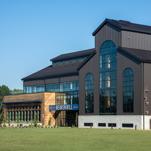Cinder Grill: Sous Vide Cooking, Without the Water?
Photos via Cinder
As a home cook with a basic understanding of most of the culinary techniques one needs to produce “restaurant-quality” food at home, I have a tendency to look at crowdfunded kitchen gadgets with a fair amount of skepticism. Kickstarter and IndieGoGo have become a breeding ground in recent years for cooking devices that continuously promise to either demystify home cookery or promote healthy eating, but the results too often fall far short of what is promised. In a sense, crowdfunded campaigns have become the new Ron Popeil-style infomercials.
Nevertheless, I was intrigued when I first started seeing videos of the Cinder Grill in action. Backed by a monumentally successful IndieGoGo campaign that achieved more than 500% of its original $50,000 goal, it promises to deliver a sous vide-style cooking device, without any need for water or vacuum-sealed bags. Although the price tag is steep, at $400-500 per unit, there’s definitely a market out there for people who want a simple device that can, at the push of a button, cook them a steakhouse-caliber piece of meat.
What I found in my own testing of Cinder was a mixed bag. I had both successes and failures making a variety of meat dishes, but I came to realize throughout that the key to getting the most out of the device was in recognizing what it actually does well, and what it does not. Suffice to say, a Cinder Grill can theoretically cook just about any piece of meat, but some are more appropriate than others.
-

-

-

-

-

-

-

-

-

-

-

-

-

-

-

-

-

-

-

-

-

-

-

-

-

-

-

-

-

-

-

-

-

-

-

-

-

-

-

-









































